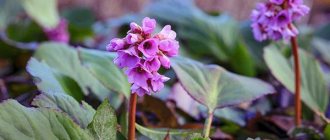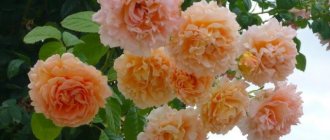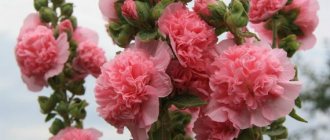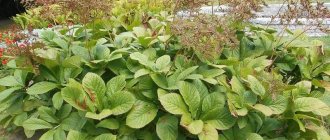History and description
Green roses were bred by the Dutch botanist Mayer. The specialist conducted numerous experiments. In 1782, he grafted a white rose onto a blackthorn shoot. The result was the appearance of a crop with green petals.
The height of the bushes depends on the variety. The shoots are powerful and have thorns. Inflorescences are small, large, medium. The color of the petals varies from a soft light green palette to a dark green color. They can be simple or terry. The buds are formed solitary or in clusters of inflorescences.
Description and shades
Peony roses originate from old English roses. These are hybrids of the famous English breeder David Austin. For example, spray rose Misty Bubbles is a bush rose from the Bubbles series (which translates as “bubbles”) has large spherical buds of pink-lilac color, is quite resistant to weather changes, is very good for cutting, and can stand in a vase for up to 10 days.
Rose Ebb Tide is one of the last varieties bred in England, famous for its rich plum shade. Belongs to the floribunda group. It has a very strong spicy clove aroma. The unusual dark, almost black-violet color covers up some imperfections (blooms in two waves with a break). Another dark purple variety is Night Owl.
An excellent rose, which is a climbing ground cover variety, and is also used as a scrub in borders, is resistant to disease, and blooms profusely - this is “Lilac Rain”. The flowers are initially crimson, then fade to a light lilac color. The rose blooms very profusely, is easy to care for, and is great for beginner gardeners.
The hybrid tea rose “Delilah” has buds of a very beautiful soft purple hue and a classic shape. This variety is suitable for single and group plantings and is good for cutting.
"Mainzer Fastnacht" is a large rose of delicate pale purple color on a long stem that does not lose its beauty even at the end of flowering.
“Lilac Fog” is a border rose of deep lilac color in bud and white-lilac when opening. It blooms very profusely and for a long time.
"Lipstick" is a widespread ground cover rose with semi-double flowers, in which the outer petals are light, almost white, and the inner petals are bright, red-violet. Very aromatic and disease resistant.
“Lavender Cordana” is one of the varieties of miniature roses with double lavender-colored flowers and a delicate aroma. They bloom all year round, they are grown in containers and pots, and brought indoors for the winter.
"Avant-garde" is a variety of Kenyan roses of light lilac color. Large flower, lasts up to 10 days when cut.
Popular varieties of green roses
Breeders have bred many roses with green petals. The most popular varieties are:
Green Ice
The bushes of the crop reach a height of 40-50 centimeters. Gardeners use low-growing plants as borders. The buds initially have a pink-green color. The petals are shaggy and twisted. At the stage of complete dissolution, the buds acquire a white-green color. In comfortable conditions, the rose blooms three times per season.
Greensleeves
The height of the bushes of this variety varies between 75-85 centimeters. The leaves are dark green, glossy. The buds at the formation stage are light pink in color. Gradually the petals acquire an emerald color. The advantage of the variety is its good resistance to black spot.
Green Tea
The height of the bush is about 90 centimeters. The shape of unopened buds is a glass. Each of them contains 25-30 petals with wavy edges. At the dissolution stage, the bud takes the shape of a deep bowl. The petals are colored light green.
Super Green
The rose of this variety is not tall. Its beauty lies in its double buds. Each flower consists of 50-130 petals. The edges of the buds are painted in a light green palette.
The middle of the flower takes on a rich color. Florists love to use Super Green for bouquets.
Limbo
The bushes of the variety are compact: the height does not exceed 80 centimeters. The leaves are large and glossy. The resulting buds are cone-shaped. When fully bloomed, the flower takes on the appearance of a bowl. The petals are painted with a yellow-green palette.
See also
Description of the best varieties of hybrid tea roses, planting and care in open groundRead
Wimbeldon
The bushes, about 1 meter high, have sparse thorns. Petals are yellow-green, wavy. The unusual thing about this variety is that there is a red stripe along the edges of the buds. The flower is loved by florists: they create beautiful compositions from the plant.
Lime Sublime
The rose variety was bred by Irish specialists. The bushes bloom profusely and for a long time. The first buds appear in late spring. Flowering lasts with a short break until the beginning of autumn. The petals are painted with a soft green palette. Lime tolerates the scorching sun well.
St. Patrick's Day
This rose variety is intended for cultivation in the southern regions, as it does not tolerate cold weather. The bud of the hybrid has a goblet shape. At the dissolution stage, the inflorescence becomes cup-shaped and reaches 12 centimeters in diameter. The petals are painted with a golden-green palette.
Gloria Dei
The main color of Gloria Day's buds is pink-yellow. The petals of the variety have only small inclusions of green color. The diameter of the inflorescences is 13-15 centimeters. The bud contains 45-50 petals. Gloria Day is the progenitor of many rose hybrids.
How to plant a green rose correctly
Many gardeners wonder when is the best time to plant such an unusual crop. It all depends on in which region of the country it is planned to grow one or another variety. In the central part, the last days of spring or the first days of summer are usually chosen for planting. If the climate is hot enough, then it is better to plant in the autumn. This way you will protect your roses from hot weather and excess sunlight.
Green rose is not an easy crop to care for. Not every gardener manages to successfully grow it on their site. But if the vagaries of a beautiful plant do not frighten you, then remember certain rules and procedures related to agricultural technology.
1) First, select good planting material. It is best to choose large stores, reliable nurseries and specialized garden stores for these purposes. You should not take seedlings from dubious private owners. When choosing seedlings, pay more attention to those plants whose rhizomes are most developed and do not have mechanical damage.
2) As a rule, planting is carried out in spring. This will give you a better chance that your seedlings will take root in their new location. If the climate is hot, organize planting a green rose in the fall. If you plan to plant your green roses in the summer, then there is a risk that the aggressive rays of the sun will harm your young bushes.
3) Gardeners most often use two methods for planting roses. In the case of the first, planting holes are prepared in advance, the plant is planted in them and thoroughly watered. Method number two is a little more difficult. Roses are planted in special containers. The container should be of such a size that the plant's root system does not feel cramped. It is necessary to fertilize; for this, gardeners use compost. You can also fertilize the soil with mineral fertilizers. In this case, you need to plant roses in the same way as in the first option. The pit is prepared in advance, a container with seedlings is placed in it, and then filled with soil. After this, the plants need to be watered thoroughly.
Specifics of cultivation and care
The decorative effect of green roses depends on planting in the right place and on timely implementation of agrotechnical measures. Purchase seedlings from plant nurseries or garden centers. There should be no dents, stains or damaged parts on the bushes. 1-2 hours before planting, the plants are placed in water, to which potassium permanganate can be added for disinfection.
Landing
Roses are planted in the ground in spring or autumn. Choose a sunny place, protected from cold winds. The culture does not tolerate lowlands and wet areas. The substrate for plants is made up of garden soil, compost, peat, sand. The hole is dug 2 weeks before planting the bushes in open ground.
Planting a green rose is done as follows:
- dig a hole 50 centimeters deep and wide;
- 10-15 centimeters are filled with drainage made of fine crushed stone, expanded clay;
- pour the fertile layer mixed with a small amount of mineral fertilizers;
- pour out the rest of the substrate in a heap;
- Place a bush in the middle, straighten the roots;
- covered with substrate.
The bush is watered abundantly and mulched.
Specifics of care
Caring for roses involves watering, fertilizing, loosening the soil, and mulching. Faded buds are cut off. This is necessary for the formation of new inflorescences, as well as for maintaining the decorative appearance of the bushes. To prevent the occurrence of diseases, plants are sprayed with fungicides in the spring.
See also
Description and characteristics of roses of the Sahara variety, subtleties of cultivationRead
Watering
The tree trunk circle is irrigated after the top layer of soil has dried. Excess moisture can lead to the appearance of putrefactive microorganisms. Water the rose in the morning or evening with warm, settled water. At least 1 bucket of water is poured under the bush.
Loosening and mulching
A few days after watering, the soil around the bushes is loosened. The procedure promotes air access to the root system. Weeding removes weeds that carry diseases and pests. To preserve moisture, the tree trunk circle is sprinkled with mulch consisting of sawdust, straw, and peat.
Top dressing
For rapid growth of shoots, abundant and long flowering, green roses are fed several times a season. In the spring, nitrogen is used, in the summer - mineral fertilizers with an advantage in the composition of potassium and phosphorus. In the fall, potassium is added, which contributes to the successful wintering of the bushes.
Trimming
Dry, broken, diseased stems are cut off throughout the season. Remove shoots growing inward. The buds that begin to dry out with parts of the branches are cut off. After this, the bushes not only look more decorative, but also begin to grow young shoots from the lateral buds.
Features of growing roses with green petals
Choose zoned varieties, purchase flowers from specialized nurseries. Inspect the seedling: it should have 2-4 skeletal branches, healthy shiny stems, roots and leaves. The root system is not damaged by rot. When purchasing seedlings with a closed root system, check the condition of the soil and the density of the earth ball.
Landing
The plant is planted on the south side of the garden plot, where there are no drafts. Roses grow well in fertile, loose soil. If the soil is clayey, you need to add sand; if it is sandy, you need to add organic matter and garden soil in equal quantities. To prevent moisture from stagnating, a drainage layer of small stones and pebbles is made at the bottom of the pit. When planting, add nutrients: dolomite flour (400 g), superphosphate (1 tbsp), peat (12 l), garden soil (1 bucket). The seedling is placed in the center of the hole, covered with earth, and the soil is compacted.
Important! The average size of the planting hole is 0.5x0.7 m.
The distance between seedlings is up to 0.5 m for low-growing and flowerbed roses, up to 3 m for bush varieties. Flowers are planted in open ground in autumn (mid-September - early October) or spring (April). Planting condition: warming of the soil to a temperature of +12ºС, absence of return frosts. In unfavorable weather conditions, flowers are planted in a container.
Diseases and pests
The appearance of diseases and pests on roses is facilitated by: unfavorable weather conditions, dense plantings, damage, and poor care. The presence of weeds increases the risk of attacks on plants by pathogenic microorganisms and harmful insects. Green roses can be affected by powdery mildew. The disease is favored by a humid environment. It is manifested by the presence of a powdery coating on the leaves and shoots. Another common crop disease is rust. The fungus causes yellow-orange bumps to form on the leaves.
The main pest of roses is aphids. It densely adheres to the shoot with the bud rudiment and drinks the cell sap. Another pest, the spider mite, is found on the underside of the leaves. Under unfavorable influence they turn yellow and fall off.
Note! To prevent the appearance of diseases and pests, bushes are treated with special preparations several times a season.
Super green
Roses of the Super Green variety are characterized by a high stem (up to 1 m), large leaves, large buds with a snow-white and light green color. Each double flower consists of 5-12 dozen petals. Only 1 strong bud blooms on the thorny stem. The flower reaches 9 cm in diameter.
The plant of this variety is not afraid of rain and diseases, in particular black spot and powdery mildew. This is a hybrid tea variety of decorative crop. It was obtained by crossing 2 varieties, tea with remontant.
Super Green flowers are popular among landscape designers. They can often be seen in flower beds and flower beds. The advantage of rose bushes of this variety is their long and continuous flowering, which can be admired throughout the summer season.
Super Green is the so-called fashion variety of roses. It is widely used in floral design.
rooting cuttings before winter.
Rooting rose cuttings can be done directly in the garden. You should first prepare a nutrient substrate based on washed coarse sand and fertile soil. Prepared rose cuttings should be buried at an angle of 45º. The planting holes should first be spilled with boiling water with the addition of potassium permanganate. The planted cuttings must be covered with plastic or glass containers, which will achieve a greenhouse effect.
The optimal temperature for rooting pink cuttings is about 25ºC during the daytime and at least 18ºC at night. An indicator of successful rooting is the appearance and development of a young shoot from the bud. After ten days, you should begin hardening the young plants by briefly removing the cover. If planting technology is followed and proper care is taken by the autumn period, the height of young shoots is about 35 cm, and all emerging buds must be pinched, which will redirect all the plant’s forces to the formation of the root system.
Rose cuttings are one of the methods of propagating roses in home gardening that are quite popular among domestic rose growers.
When creating a rose garden, experts in the field of floriculture recommend paying attention not only to the attractiveness and compatibility of the flower arrangement, but also to the botanical features of the crops grown together:
roses cannot be grown in the same space as gladioli and dahlias, since these ornamental crops can have a depressing effect on each other;
a classic addition to roses can be planting sage, bluebells, speedwell and foxglove;
Almost any flowering annuals look very good with roses;
a good “companion” for green-flowered roses is bulbous ryegrass;
decorative and beautifully blooming throughout the season, heuchera, lobelia and cineraria do not overwhelm roses and serve as a worthy frame for the “queen” of flowers;
you can fill the space between rose bushes with plantings of thyme, oregano, hyssop, lavender, sage, lofanta, loosestrife, yarrow Ptarmika, phalaris and hakonechloa.
Roses cannot be grown in the same space as gladioli and dahlias, as these ornamental crops can have a depressing effect on each other
» A highly decorative composition can be obtained by planting a green rose with garden hydrangeas. Both crops grow well and bloom profusely in slightly shaded areas with slightly acidic soils. As a temporary decorative display, we can recommend adding rose bushes with lilies.”
Green roses should not be underestimated, and the fairly rich range of colors and shades opens up enormous scope for creativity and allows you to discover new possibilities for landscape design when decorated in different styles.
The most popular rose bushes in landscape design are Green Ice varieties.
Classification of roses
The wide range of colors and shapes offered by roses is a result of their ability to freely cross-pollinate, both in the wild and in cultivation.
Complex hybridization over thousands of years, as well as poor record keeping and the once-secret practices of hybridizers, have made it difficult to establish the lineage of many such plants. As a result, their classification sometimes clouds even experts.
All of them belong to the genus of the same name, of which there are about two hundred types and many thousands of hybrid ones.
Let's celebrate! Hybrids do not belong to a specific phylum and therefore do not have common botanical names. Instead, they are identified by the names of the varieties that their hybridizers assigned.
Hybrid tea varieties
Hybrid tea plants are considered one of the oldest classes. It is believed that it began with the species "LaFrance" back in 1867. This class was created by crossing a tea fruit with a hybrid everlasting rose. After this, several other similar types were made, but the popularity did not cease until the Peace Rose was officially recorded in 1945.
Gloria Day - this class is considered one of the most significant and beautiful roses. This variety was bred in France in the mid-19th century. According to historical data, it is “Gloria Day” that is considered a symbol of peace and universal harmony. The color is delicate yellow-pink with many petals. Ideal for cultivation in both Northern and Southern parts of the world, it is not picky and does not require special care.
Dolce Vita is another class of hybrid tea rose that features delicate mixed flowers in shades of pink and white. The shape resembles a glass, the ripening period lasts all summer, however, their flowering time is very long. These roses are ideal for any special occasion or as a gift. They grow in various climate zones and do not require special care other than pruning.
Queen Elizabeth - this rose has a soft pink color. As a rule, they are planted in places where it is necessary to add emphasis and insert a bright spot. This is really a very bright, but at the same time, delicate plant. However, special care will be required - protection from winds, shelter and pruning.
Blessing is a salmon-colored class with virtually no aroma. Such flowers are relatively resistant to rain and wind. But nevertheless, it is recommended to grow them in warm areas. The ripening period is all summer, several times per season.
Flamingos are one of the types that have unusual colors - soft pink colors, reminiscent of flamingos, and white edges with a hint of silver. They also do not have a strong aroma; the ripening period continues throughout the summer. Grown mainly in warm regions.
Big Purple - have a bright and beautiful color. Their color is bright pink with a hint of burgundy. They have an unusual shape, which contributed to such great popularity. They require special care and are not at all adapted to rain. The ripening period is all summer.
Floribunda . This class has several varieties - these are curb, medium and high types. Also, they have several colors, not just one. These are light-loving and heat-loving plants that are not adapted to rain and require special care.
Angela . These flowers have a crimson color and are great for gardens and other decorations. The ripening time begins in late spring and ends in autumn. These are highly adaptable plants that can grow in a variety of climates and can withstand a lot of rainfall.
Leonardo da Vinci . This is a class with an unusual shape. If all other types resemble a glass, then this rose has a round shape. They are grown in gardens and can be given as a gift in a special occasion. Very hardy plants that can adapt anywhere and do not require additional care.
Bonika 82 . These are cream-pink flowers that have pink in the center and cream along the very edges of the petals. This coloring is the most pleasant and unusual for creating solemnity. The time to ripen is all summer and early autumn. Resistance to insects and rainy weather is average.
Deutsche Welle . An unusual tea rose that has an interesting purple color. It has a fresh, non-intrusive aroma. They are very resistant to rain and harmful insects. The flowering period continues throughout the summer and early autumn. Necessary care is pruning and timely watering.
climbing roses
Climbing plants can be higher quality and larger than shrubby vegetation. They can beautifully decorate any building, fence or veranda. There are many opportunities for plant seedlings.
Alberic Barbier . This is one of the types of wicker plants, which is distinguished by the beauty of its flowers, which have a chrome hue and growth rate. This type was developed in France back in 1990. These are very hardy plants to any weather conditions and sudden changes in weather.
Super Excelsa . These are bright pink plants and are considered a developed breed. It was presented as a hybrid fruit, which is practically not susceptible to various plant diseases and capriciousness to weather conditions.
New Dawn . These are white flowers with some light pink coloring on the edges of the petals. Such a delicate combination makes it special. They have a distinct aroma. The time to ripen is all summer and early autumn. Tolerance to harmful insects and rainy weather is average.
Rosarium Uetersen . This is a standard pink rose that has a delicate and strong apple scent. These species are very tolerant of hot and cold conditions. The duration of ripening is from the end of May to the beginning of September. They do not require special care or additional coverings.
Compensation . Another type of unusually beautiful climbing plants that are distinguished by many colors in one whole. These are pink, salmon, and orange shades together. This is far from the easiest class to grow and will require additional care. Resistance to rain and insects is low. Prefers warm weather conditions.
Super Dorothy . An interesting type that from a distance looks more like a lilac. This is due to the fact that such flowers have many petals, which add sophistication and lightness. A very resistant plant to insects and rainy weather. They do not require special care and are easy to grow.
Ground cover roses
The so-called groundcover varieties can be considered the hobbits of the entire genus - small in stature, spreading in girth. These plants are, for the most part, tough, hard-working garden plants. Like all flowers of this genus, they appreciate generous food, but otherwise they are undemanding.
Swani . These are white flowers that grow in large inflorescences - 5-10 roses in one armful. The ripening period is quite possessive - from spring to late autumn. These are low-growing plants that will be an excellent decoration, for example, for paths and other partition areas.
Ballerina (Ballerina). The fruits of the flowers are light pink in color and small in size with a delicate musk aroma. The time for ripening is all summer and autumn (until the onset of the first frost).
Sommerwind . One of the types of ground cover plants that have a pink tint, which is light at the beginning of flowering, and over time, darkens to a burgundy hue. In one cluster you can find up to 30 flowers, which indicates the high activity of their flowering. They are quite hardy to rain and different climatic zones.
Rosy Carpet . This is a standard decoration for any garden to create a bright and delicate image. The color is bright pink. One handful can contain from 5 to 7 flowers. Resistance to insects, rain and frost is average. The time to ripen is all summer, several times a season.
Pink Floriland . This is a very successful decoration for your own garden. As a rule, it is not customary to plant such classes in large quantities, because They look most impressive individually. Their ripening time is long, right from spring until late autumn. Tolerance to insects and weather conditions is average.
Sedana . This is a very beautiful class, the flowers have a coral color. The plant is very resistant to diseases and insects, which can contribute to the extinction of the flower. They love light very much and are not adapted to cold weather. Therefore, in winter they require global shelter.
Park roses
There are separate classes called park flowers. It is no coincidence that they have this name. Park plants, as a rule, are usually planted in those places where there is ample space for free and comfortable growth.
The fact is that they are not so large in length, but as a rule, shrubs are very wide and therefore need space for free growth.
Pink Robusta . The most famous class of park plants, which easily adapt to any type of soil, are not demanding on weather conditions and relatively low temperatures. These are bright pink fruits, the ripening period of which lasts all summer until frost begins.
Chloris . These are white flowers that sometimes show pink hues. They do not have a standard appearance, but a very lush shape and numerous petals, which makes them the most interesting as a gift for any significant event. This class is very picky about rain and frost. It's time to ripen - only once during the entire season.
Hansa . This is one of the most suitable classes for garden cultivation. These types have everything they need. They are distinguished by prickly and numerous thorns, bright pink fruits and a lush shape. Very hardy plants with a long ripening period.
Jacques Cartier . This type is ideal for growing in cold areas. The fact is that such a plant adapts well to a wide variety of weather conditions and blooms for a long time. Delicate pink flowers with a bright aroma and lush shape.











